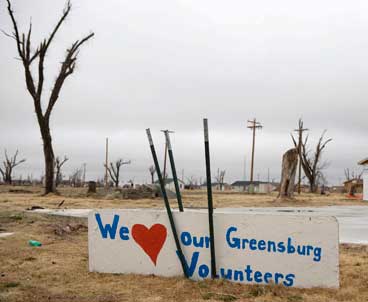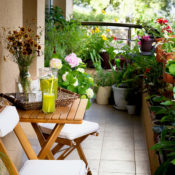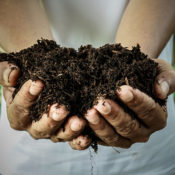Sharon Schmidt and her son Morgan were heading home to Greensburg, Kansas, when her other son, Taylor, called from an out-of-town high school trip.
“Mom, there’s a tornado heading toward Greensburg. Don’t go there,” he urged, after watching a weather alert. But Sharon pressed on, into darkness, past downed telephone poles and power lines. They smelled gas from countless broken mains.
“The homes were all gone,” she says. “Our big church was just gone. You could see from one side of town to the other.”
“Mom, I think your house is gone,” Morgan said.
It was, along with about 95 percent of the homes and buildings in the rural town of 1,400 people. On May 4, 2007, a 2-mile-wide, EF5 tornado—the highest level—swept through Greensburg. Eleven people died, and nearly everyone lost their homes. Yet, in the wake of the destruction and disaster, city leaders saw an opportunity.
“We had a clean slate, so why not do things right?” says former City Council President John Janssen. City officials envisioned a model for other communities.
Like rural towns across the country, Greensburg’s population had been shrinking. Starting from scratch allowed them to design for the future. To attract people and jobs and induce young adults to return, they reasoned they had to be sustainable, reducing water and energy use and getting power from renewable sources such as wind or sun.
“We talked about smarter building, better planning, and better facilities,” says city administrator Steve Hewitt.
Slowly, painfully, the town became more than another tale of disaster and death; it became a story of hope.
Green Glossary |
| Tankless water heaters Unlike conventional water heaters that keep water heated around the clock, tankless water heaters are designed to heat water on demand, saving up to 40 percent of energy use. |
| LEED Leadership in Energy and Environmental Design is a rating system developed by the U.S. Green Building Council, a body of architects, engineers, designers, builders, and government agencies, that establishes standards of measuring what makes a building green. |
| Green-collar job Jobs created by businesses whose mission is to improve environmental quality, such as energy auditors, insulation installers, solar installers, recycling operators, etc. |
| Green roof A roof covered with plants that absorb rainwater and reduce the roof’s heat absorption. |
| Geothermal heating and cooling Also known as ground-source heat pumps, geothermal systems use the earth’s constant temperature of about 55 degrees to heat and cool a building, potentially saving homeowners 40 percent to 70 percent in heating costs and 30 percent to 50 percent in cooling costs. |
| Photovoltaic solar panels System that provides renewable energy by harnessing sunrays. |
Unlikely Ambassadors
Before the tornado, most Greensburg residents had never heard of photovoltaic solar panels, tankless water heaters, and geothermal heating and cooling systems (see sidebar).
“We weren’t tree-huggers by any stretch,” Janssen says. “There was a lot of pressure to build the town back just the way it was.” Instead, the city council voted unanimously to build municipal structures to meet the U.S. Green Building Council’s Leadership in Energy and Environmental Design (LEED) platinum certification, the highest designation. To meet LEED standards, buildings are given points for each environmentally sustainable feature, such as using daylight rather than artificial light, installing water-saving systems, and using reclaimed materials like wood or bricks. The more points earned, the higher the rating. Both the up-front costs and long-term savings are usually greater with higher sustainability ratings.
“Everybody was pretty skeptical,” says Stacy Barnes, 27, who works as the executive director of the 5.4.7 Arts Center and director of the town’s historic tourist attraction, the Big Well, the world’s largest hand-dug well. But today, about 80 percent of the community supports the decision to go green.
The Estes brothers rebuilt their BTI John Deere dealership facility to LEED platinum specifications, and Iowa-based John Deere Renewable Energy is building a wind farm to meet the city’s power needs. In addition, the Dwane Shank Motors GM dealership that was rebuilt to green standards has become a corporate beacon. General Motors unveiled its electric Chevrolet Volt at the Greensburg dealership.
About 900 people now live in Greensburg, some from outside the area. The disaster got so much attention, including a reality show on Discovery Network’s Planet Green, that cash donations, volunteers, and materials poured in.
“There’s going to be a higher concentration of energy- efficient buildings in this small Kansas town than anywhere,” says resident Farrell Allison. Nearly all the homes were circa 1950 or earlier, so most new homes are more energy efficient and contain more insulation and better windows.
Faith in the Future
Greensburg is a deeply religious community. When the tornado struck, “I know God’s name was on everyone’s lips. We don’t have a basement. I believe God placed us where we were,” says Schmidt. “The toll could have been hundreds of deaths.” The fire chief ordered 300 body bags.
Losing everything changed priorities. “You learn that your family is more important than things,” says Alexsis Fleener, 17, a high school senior. But people also saw this as an opportunity to “change the world,” says Taylor Schmidt, who, like Alexsis, was a co-founder of the high school’s green club.
“We’re all part of the same environment. We all breathe the same air and drink the same water,” says Daniel Wallach, executive director of GreenTown, a nonprofit organization created to help Greensburg rebuild sustainably. “We can agree that we are concerned about the future for our children.”
Darin Headrick, the school superintendent, certainly felt that way. He promised school would open 88 days after the tornado struck. Classes met in temporary buildings at first, and nearly 75 percent of the students returned.
Headrick’s commitment played a pivotal role in bringing people back. If children had to be educated in other towns, more families would have left permanently. The new school building will open this fall. The students themselves have helped with construction of the school, which will be a place of learning for kids and visitors alike.
“The mechanical stuff inside the building will have glass windows so you can see how everything works,” Alexsis says. She wanted to be a veterinarian, but now plans to study sustainability and community planning in college. “The green movement changed me and what I wanted to do.”
Hewitt and his staff still face struggles and conflicts. “The jury is still out on us,” Hewitt says. “I think we’ve come an amazing way in two and a half years.”
The city’s leaders, such as Hewitt, are routinely asked to speak and educate others about the greening of Greensburg. “We’re the new pioneers of the 21st century. In Greensburg, Kansas, everybody is doing what they can, at whatever level they can. We’ve all got to start making a difference.”
People made a difference for Sharon Schmidt after she and her son Taylor lost their home. Volunteers from a Mennonite group built Schmidt’s new home using energy-efficient, tornado-resistant Insulated Concrete Form (ICF) blocks.
“If you’re going to come back in western Kansas, you’ve got to have something going for you,” adds Schmidt. “I think it’s going to be a model city 10 years down the road. I feel excited for Taylor’s generation.”
Become a Saturday Evening Post member and enjoy unlimited access. Subscribe now




Comments
My heart-felt admiration and repect to the people of Greensburg, Kansas !